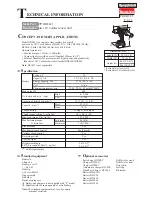
In the event that it becomes necessary to store the tool for an extended period of time (overnight,
weekend, etc.) lubricate the tool generously. The tool should be run for approximately 30 seconds
to ensure that the oil has been evenly distributed throughout the tool. The tool should be stored in a
clean and dry environment.
It is most important that the tool be properly lubricated by keeping the air line lubricator filled
and correctly adjusted. Insufficient lubrication will affect tool performance and parts will wear
prematurely.
Use the correct lubricant in the air line lubricator. The lubricator should be a low air
flow or changing air flow type, and should remain filled to the correct level. Use only
recommended lubricants, specially made for pneumatic applications. Substitutes may harm the
rubber compounds in the tools O-rings and other rubber parts.
IMPORTANT:
If a filter-regulator-lubricator is not installed on the air system, air operated tools should
be lubricated at least once a day or after 2 hours work with 2 to 6 drops of oil, depending on the work
environment, directly through the male fitting in the tool housing.
Operating Instructions
Loading and Operation
WARNING:
Ensure you read, understand and apply safety instructions before use.
1.
Connect the air tool to the air hose.
2.
Press the trigger to operate the tool.
3.
To change direction push the button at the top of the handle. Direction of “R” for reverse and “F”
for forward.
4.
The flow of air may be regulated by adjusting the flow valve at the base of the handle.
5.
Ensure the air supply is clean and does not exceed 90psi while operating the air tool. Unclean
air or too high an air pressure will shorten the product life due to excessive wear and may be
dangerous, causing damage or personal injury.
DO NOT allow air tool to free run for an extended period of time as this will shorten its life.
Maintenance
WARNING:
Disconnect air tool from air supply before changing accessories, servicing or
performing maintenance. Replace or repair damaged parts. Use genuine parts only. Non-authorised
parts may be dangerous.
1.
Lubricate the air tool daily with a few drops of air tool oil, dripped into the air inlet.
2.
Loss of power or erratic action may be due to the following:
a) Excessive strain on the air line. Moisture or a restriction in the air pipe.
b) Grit or gum deposits in the air tool. If your model has an air strainer (located in the area of
the air inlet), remove the strainer and clean it.
3.
When not in use disconnect from air supply and store in a safe, dry, childproof location.



























